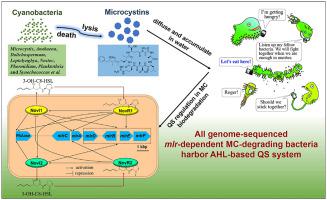Water Research ( IF 11.4 ) Pub Date : 2020-06-22 , DOI: 10.1016/j.watres.2020.116092 Yan-Hua Zeng 1 , Zhong-Hua Cai 1 , Jian-Ming Zhu 1 , Xiao-Peng Du 1 , Jin Zhou 1

|
Microcystins (MCs) are the most common cyanotoxins produced by harmful cyanobacterial blooms and pose an increasing global threat to human health and ecosystems. Microbial degradation represents an efficient and sustainable approach for the removal of MCs. Although the enzymatic pathway for biodegradation of MCs has been characterized, the regulatory mechanisms underlying the degradation processes remain unclear. Quorum sensing (QS) is a cell-density-dependent regulatory mechanism that enables bacteria to orchestrate collective behaviors. The acyl-homoserine lactone (AHL)-mediated QS system regulates the biodegradation of many organic pollutants. However, it is not known whether this QS system is involved in the degradation of MCs. This study aimed to fill this knowledge gap. In this study, the proportion of culturable AHL-producers increased significantly after enrichment of MCs, and AHL-based QS systems were present in all genome-sequenced MC-degrading strains, supporting the hypothesis that QS participates in the degradation of MCs. Two bifunctional Novosphingobium strains (with MC-degrading and AHL-producing abilities) were isolated using a novel primer pair targeting mlrA, the marker gene of mlr degradation pathway. Biochemical and genetic analysis revealed that the MC-degrading bacterium Novosphingobium sp. ERW19 encodes two hierarchical regulatory QS systems designated novR1/novI1 and novR2/novI2. Gene knockout and complementation experiments indicated that both systems were required for efficient degradation of MCs. Transcriptomic analyses revealed that the QS systems positively regulate degradation of MCs through transcriptional activation of MC-degrading genes, especially mlrA. Given that QS may be a common trait within mlr pathway-dependent MC-degrading bacterial strains and the degradation activity is directly regulated by QS, manipulation of the QS systems may be a promising strategy to control biodegradation of MCs.
中文翻译:

新孢子虫中的两个分层LuxR-LuxI型群体感应系统通过mlr途径的转录调控激活微囊藻毒素降解。
微囊藻毒素(MCs)是有害蓝藻繁殖产生的最常见的蓝藻毒素,对人类健康和生态系统构成了日益严重的全球威胁。微生物降解代表了一种有效且可持续的去除MC的方法。尽管已表征了MCs生物降解的酶促途径,但降解过程的调控机制仍不清楚。群体感应(QS)是一种依赖细胞密度的调节机制,可使细菌协调集体行为。酰基高丝氨酸内酯(AHL)介导的QS系统调节许多有机污染物的生物降解。但是,尚不清楚此QS系统是否参与MC的降级。这项研究旨在填补这一知识空白。在这个研究中,MC富集后,可培养的AHL生产者的比例显着增加,并且在所有基因组测序的MC降解菌株中均存在基于AHL的QS系统,支持了QS参与MC降解的假设。两个双功能使用靶向mlrA(mlr降解途径的标记基因)的新型引物对,分离了具有新霉素的菌株(具有MC降解和产生AHL的能力)。生化和基因分析表明,MC降解细菌Novosphingobium sp。ERW19对两个分层的监管QS系统进行编码,分别称为novR1 / novI1和novR2 / novI2。基因敲除和互补实验表明有效降解MCs需要两个系统。转录组学分析表明,QS系统通过MC降解基因的转录激活正调控MC的降解,特别是mlrA。鉴于QS可能是依赖于mlr途径的MC降解细菌菌株的共同特征,并且降解活性直接由QS调节,因此QS系统的操作可能是控制MCs生物降解的有前途的策略。











































 京公网安备 11010802027423号
京公网安备 11010802027423号